A Study to Resist Conduced Interference from GIS Bus-Charging Currents Switching for Electronic Current Transformer
Abstract
1. Introduction
- The cut-off frequency of the Rogowski coil is reduced as much as possible, and the VFTC with high frequency and high amplitude is attenuated effectively.
- A TVS and an active filter are added to suppress the conducted interference with high frequency and high amplitude, and the Cy capacitor is used to solve the problem of PCB ground interference. A detailed method is also provided, which can design and calculate the cut-off frequency of the Rogowski coil and the parameter selection of the TVS, the filter and Cy capacitance in the sampling unit.
- The arc extinction is judged by VFTC attenuation to zero instead of the VFTC zero-crossing.
- The complete GIS interval installed with the ECT is connected to the experimental circuit, which makes our experiment more in line with the practical application of engineering.
2. Simulation Models of GIS Disconnector Switching Circuit and Electronic Current Transformer
2.1. Connection Modes of Test Circuit
2.2. High-Frequency Simulation Model of VFTC Generated by GIS Disconnector Switching
2.3. Simulation Model of Electronic Current Transformer Sensor and Integral Filter
3. Simulation and Result Analysis
3.1. Subsection Simulation and Result Analysis of VFTC Signal Conduction in a Single Breakdown
3.2. Simulation and Result Analysis of VFTC Signal Conduction in Multiple Breakdowns
4. Immunity Test of ECT When Disconnector Switching Small Capacitive Current
5. Conclusions
- During the switching process of the disconnector, the VFTC produced with the VFTO is the root of conducting interference generated by the GIS ECT. The cut-off frequency of the Rogowski coil (≥1 kHz) is reduced as much as possible on the premise of the ECT installation size to greatly attenuate the high-voltage and high-frequency signal.
- In view of the characteristics of the response simulation waveform of each node in single and multiple breakdowns, the TVS selected in this paper can effectively intercept signals ≥10 V; the designed 1 kHz filter can effectively filter out high-frequency signals (≤68 kHz) and the selected 2200 pF capacitor Cy provides the fastest low-impedance release circuit for the PCB ground interference (≤60 MHz). The above design ensures that the output interference of the ECT does not exceed 40% of the rated current during the opening and closing process of the disconnector switch, which meets the requirements of the evaluation standard.
- The experimental test was carried out to measure the output value of the merging unit during the switching process of the disconnector. As derived from the measurement, the residual charge of the integrated capacitor discharges exponentially with the time constant τ = 1 s after arc extinguishing, and its characteristics are consistent with the simulated waveform, which demonstrates the equivalence of the simulation model built in this paper. In the design of the conducted interference of the 110 kV and higher voltage level ECT, the simulation has a certain universality and popularizing value.
Author Contributions
Funding
Institutional Review Board Statement
Informed Consent Statement
Data Availability Statement
Conflicts of Interest
References
- Smeets, R.R.; Van Der Linden, W.; Achterkamp, M.; Damstra, G.; De Meulemeester, E. Disconnector switching in GIS: Three-phase testing and phenomena. IEEE Trans. Power Deliv. 2000, 15, 122–127. [Google Scholar] [CrossRef]
- Haznadar, Z.; Carsimamovic, S.; Mahmutcehajic, R. More accurate modeling of gas insulated substation components in digital simulations of very fast electromagnetic transients. In Proceedings of the Power Industry Computer Application Conference, Sydney, Australia, 7–10 May 1991. [Google Scholar]
- Heimbach, M. VFT studies on current and voltage transformers in GIS by means of an iterative pole-zero-removal method for simulating the transfer function. In Proceedings of the Ninth International Symposium on High Voltage Engineering, Graz, Austria, 28 August–1 September 1995; pp. 6751–6752. [Google Scholar]
- Heimbach, M.; Grcev, L. Grounding system analysis in transients programs applying electromagnetic field approach. IEEE Trans. Power Deliv. 1997, 12, 186–193. [Google Scholar] [CrossRef]
- Limin, F.; Xiaobo, W.; Lianzi, W. Study on the impact of VFTO electromagnetic interference on electronic transformers in 500 kV GIS substation. Trans. China Electrotech. Soc. 2016, 31, 85–90. [Google Scholar]
- Wiggins, C.; Thomas, D.; Nickel, F.; Salas, T.; Wright, S. Transient electromagnetic interference in substations. IEEE Trans. Power Deliv. 1994, 9, 1869–1884. [Google Scholar] [CrossRef]
- Liu, B.; Ye, G.; Guo, K.; Tong, Y.; Hu, B.; Wan, G. Quality test and problem analysis of electronic transformer. Gaodianya Jishu High Volt. Eng. 2012, 38, 2972–2980. [Google Scholar]
- Li, Z.; Shen, J.; Li, H.; Wu, L.; Zhang, T.; Xu, Y. Research on Arc Model of Disconnector for Conduction Interference of Electronic Transformer. In Proceedings of the 2019 4th International Conference on Intelligent Green Building and Smart Grid (IGBSG), Yichang, China, 6–9 September 2019; pp. 443–447. [Google Scholar]
- Lin, C.; Zhu, Y.; Chen, F.; Yu, H.; Zhang, C.; Liu, X.; Wang, W.; Wang, Y.; Deng, X.; Gao, J.; et al. Research on Electromagnetic Interference of Smart Device Acquisition Unit under GIS Disconnector Operation. IOP Conf. Ser. Mater. Sci. Eng. 2018, 452, 042190. [Google Scholar] [CrossRef]
- Zhenhua, L.; Weizhong, H.; Suhong, Y. Conductive interference analysis and anti-interference methods of electronic transformers in disconnector switching test. High Volt. Eng. 2016, 42, 233–240. [Google Scholar]
- Zhang, J.; Zhao, J.; Xie, P. Simulation and analysis of electromagnetic properties at the secondary port of electronic current transformers under very fast transient overvoltage. Trans. China Electrotech. Soc. 2015, 30, 88–94. [Google Scholar]
- Bai, S.; Zeng, L.; Rong, M.; Li, Y.; Chen, K.; Zhang, Y. Interference Analysis and Protection of Electronic Current Transformer Caused by Disconnect Switch Operation in GIS. High Volt. Appar. 2016, 52, 54–62. [Google Scholar] [CrossRef]
- Bai, S.; Zeng, L.; Li, Y.; Zhang, C.; Jia, L. Anti-interference Measures Research and Protection of Electronic Transformer Applied in Engineering. High Volt. Appar. 2016, 52, 187–193. [Google Scholar] [CrossRef]
- Rao, M.; Thomas, M.; Singh, B. Frequency Characteristics of Very Fast Transient Currents in a 245-kV GIS. IEEE Trans. Power Deliv. 2005, 20, 2450–2457. [Google Scholar] [CrossRef]
- Wei, M.; Wu, X.; Yu, G.; Tian, Y.; Wu, S. Study on Transient Characteristics of VFTC in 1 100 kV GIS Substation. Electr. Power 2016, 49, 1–8. [Google Scholar] [CrossRef]
- Chai, Y.Y.; Wouters, P.A.A.F.; Van Hoppe, R.T.W.J.; Smeets, R.P.P.; Peelo, D.F. Capacitive Current Interruption with Air-Break High Voltage Disconnectors. IEEE Trans. Power Deliv. 2010, 25, 762–769. [Google Scholar] [CrossRef]
- Chai, Y.; Wouters, P.A.A.F.; Smeets, R.P.P. Capacitive Current Interruption by HV Air-Break Disconnectors with High-Velocity Opening Auxiliary Contacts. IEEE Trans. Power Deliv. 2011, 26, 2668–2675. [Google Scholar] [CrossRef]
- Narimatsu, S.; Yamaguchi, K.; Nakano, S.; Maruyama, S. Interrupting Performance of Capacitive Current by Disconnecting Switch for Gas Insulated Switchgear. IEEE Trans. Power Appar. Syst. 1981, PAS-100, 2726–2732. [Google Scholar] [CrossRef]
- Bojic, P. Bus charging current switching in GIS by disconnector. IEEE Porto Power Tech Proc. 2002, 3, 6. [Google Scholar] [CrossRef]
- Duan, S.; Zhan, H.; Li, C.; Zhao, L.; Yao, L. Measurement and modelling of Very Fast Transient Current in 220 kV GIS. Vacuum 2015, 120, 32–36. [Google Scholar] [CrossRef]
- Liu, B.; Ye, G.; Tong, Y. Influence of disconnector in gas insulated switchgear switching on/off on electromagnetic compatibility of electronic transformer. High Volt. Eng. 2018, 44, 1204–1210. [Google Scholar]
- IEC 62271-102-2001. High-Voltage Switchgear and Controlgear—Part 102: Alternating Current Disconnectors and Earthing Switches. Available online: https://sales.sfs.fi/fi/index/tuotteet/IEC/IEC/ID9988/6/333413.html.stx (accessed on 23 July 2020).
- IEC. Instrument Transformers Part 8 Electronic Current Transformers; IEC: Geneva, Switzerland, 2002. [Google Scholar]
- GB/T 20840. 8-2007. Instrument Transformers-Part 8: Electronic Current Transformers. Available online: https://www.chinesestandard.net/PDF/English.aspx/GBT20840.8-2007 (accessed on 23 July 2020).
- Duan, S.; Zhao, L.; Li, Z.; Zhan, H.; Li, C. Experimental and simulation study on statistical characteristics of VFTO and VFTC in GIS. Power Syst. Technol. 2015, 39, 3634–3640. [Google Scholar]
- Kumar, V.; Thomas, J.; Naidu, M. Influence of switching conditions on the VFTO magnitudes in a GIS. IEEE Trans. Power Deliv. 2001, 16, 539–544. [Google Scholar] [CrossRef]
- Carsimamovic, S.; Bajramović, Z.; Ljevak, M.; Veledar, M. Very fast electromagnetic transients in air insulated substations and gas insulated substations due to disconnector switching. In Proceedings of the 2005 International Symposium on Electromagnetic Compatibility, Chicago, IL, USA, 8–12 August 2005. [Google Scholar]
- Tavakoli, A.; Gholami, A.; Parizad, A.; Soheilipour, H.; Nouri, H. Effective factors on the very fast transient currents and voltage in the GIS. In Proceedings of the 2009 Transmission & Distribution Conference & Exposition: Asia and Pacific, Seoul, Korea, 26–30 October 2009; pp. 1–6. [Google Scholar]
- Reddy, P.R.; Amarnath, J. Simulation of Mitigation Methods for VFTO’S And VFTC’S in Gas Insulated Substations. In Proceedings of the 15th IEEE conference on Advanced Computing Technologies (ICACT), New Boyanapalli, India, 21–22 September 2013. [Google Scholar]
- Miri, A.; Stojkovic, Z. Transient electromagnetic phenomena in the secondary circuits of voltage and current transformers in GIS (measurements and calculations). IEEE Trans. Power Deliv. 2001, 16, 571–575. [Google Scholar] [CrossRef]
- Huamao, Z.; Chengnan, Z.; Shaofeng, D. Measuring of very fast transient over-voltage and very fast transient current generated by disconnector in gas insulated switchgear switching on/off short buses with no load. High Volt. Eng. 2013, 39, 1317–1323. [Google Scholar]
- Yinbiao, S.; Bin, H.; Ji-Ming, L.; Weijiang, C.; Liangeng, B.; Zutao, X.; Guoqiang, C. Influence of the Switching Speed of the Disconnector on Very Fast Transient Overvoltage. IEEE Trans. Power Deliv. 2013, 28, 2080–2084. [Google Scholar] [CrossRef]
- Du, W.; Li, Y.; Liu, J. A new VFTO whole process simulation method based on time domain finite element. Proc. CSEE 2014, 34, 3004–3012. [Google Scholar]
- Filho, J.G.R.; Teixeira, J.A.; Sans, M.R.; Martinez, M.L.B., Jr.; Teixeira, J.A. Very fast transient overvoltage waveshapes in a 500-kV gas insulated switchgear setup. IEEE Electr. Insul. Mag. 2016, 32, 17–23. [Google Scholar] [CrossRef]
- Zhang, Y. Simulation Analysis and Design of Rogowski Coil Current Transformer; Haerbin Institute of Technology: Haerbin, China, 2006; pp. 56–58. [Google Scholar]
- Jiao, C.; Zhang, J.; Zhao, Z.; Zhang, Z.; Fan, Y. Research on Small Square PCB Rogowski Coil Measuring Transient Current in the Power Electronics Devices. Sensors 2019, 19, 4176. [Google Scholar] [CrossRef]
- Xie, B.; Yin, X.-G.; Zhang, Z.; Li, W. Technology in designing integrator of electronic current transducer based on Rogowski coil. Relay 2007, 35, 45–50. [Google Scholar]
- Wang, J.; Si, D.; Tian, T.; Ren, R. Design and Experimental Study of a Current Transformer with a Stacked PCB Based on B-Dot. Sensors 2017, 17, 820. [Google Scholar] [CrossRef] [PubMed]
- Ma, Y.; Xia, Y.; Song, B.; Shen, Z.; Wang, H. Quantitative Analysis of Time Constant of Analog Integrator Used for Air-core Coil. Shandong Electr. Power 2019, 46, 21–25. [Google Scholar] [CrossRef]
- ZHENG, Y. Analysis on abnormal magnetizing inrush current output from electronic current transformer when no-load transformer operates. Autom. Electr. Power Syst. 2017, 41, 188–193. [Google Scholar]
- Zheng, J. Electromagnetic Compatibility (EMC) Design and Test Case Analysis; Wiley: Hoboken, NJ, USA, 2019. [Google Scholar]
- He, J.; Li, X. Interaction of X-capacitor and Y-capacitor Between Electrical Safety and EMC Performance. Safety EMC 2019, 31–33, 38. [Google Scholar]
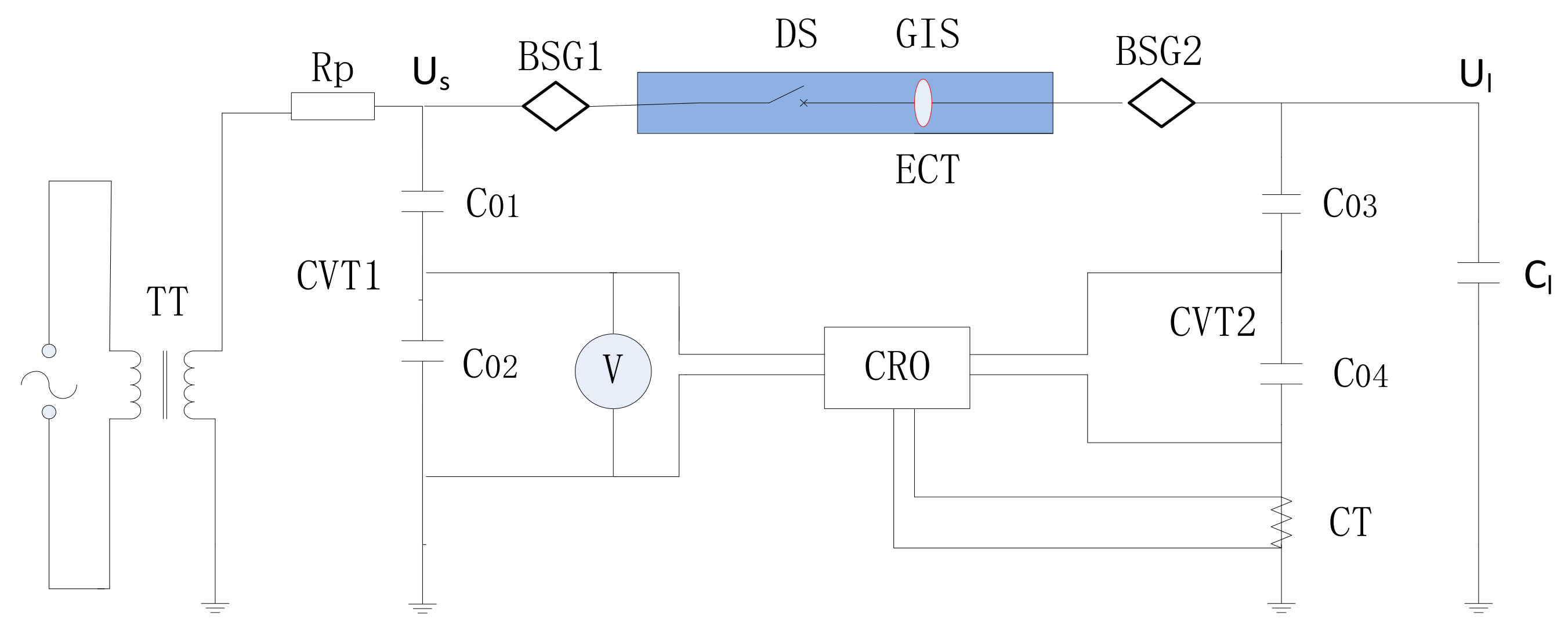

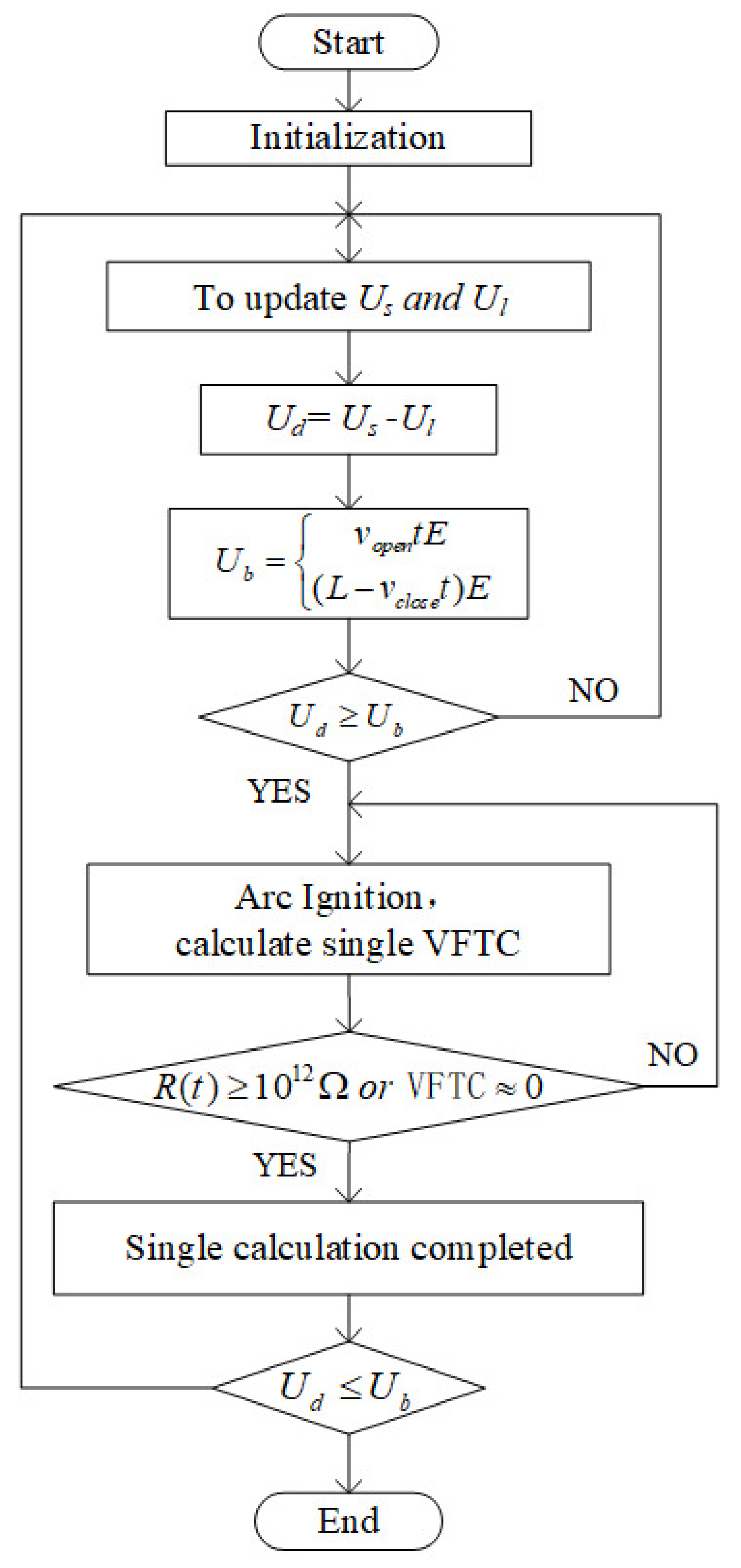

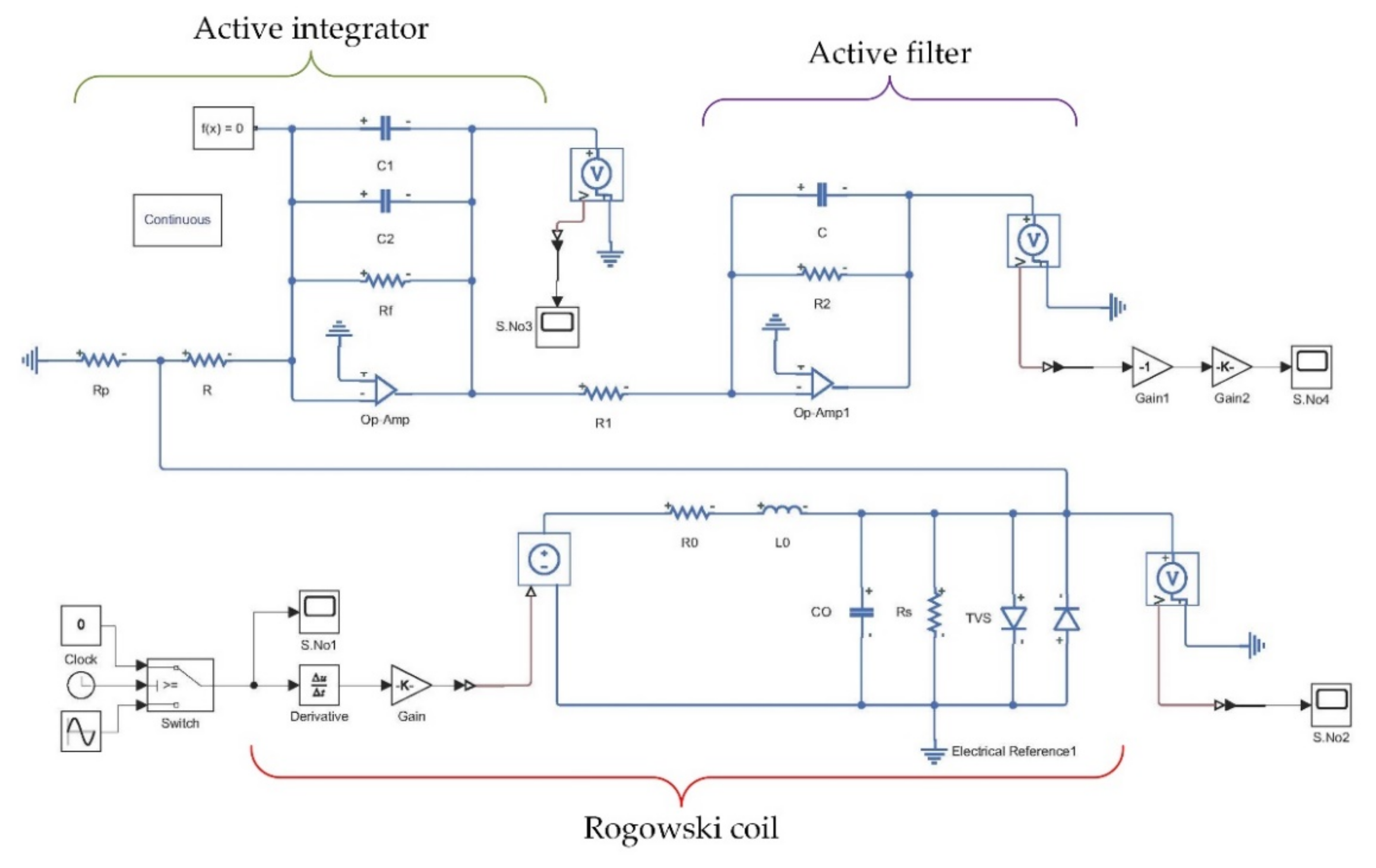










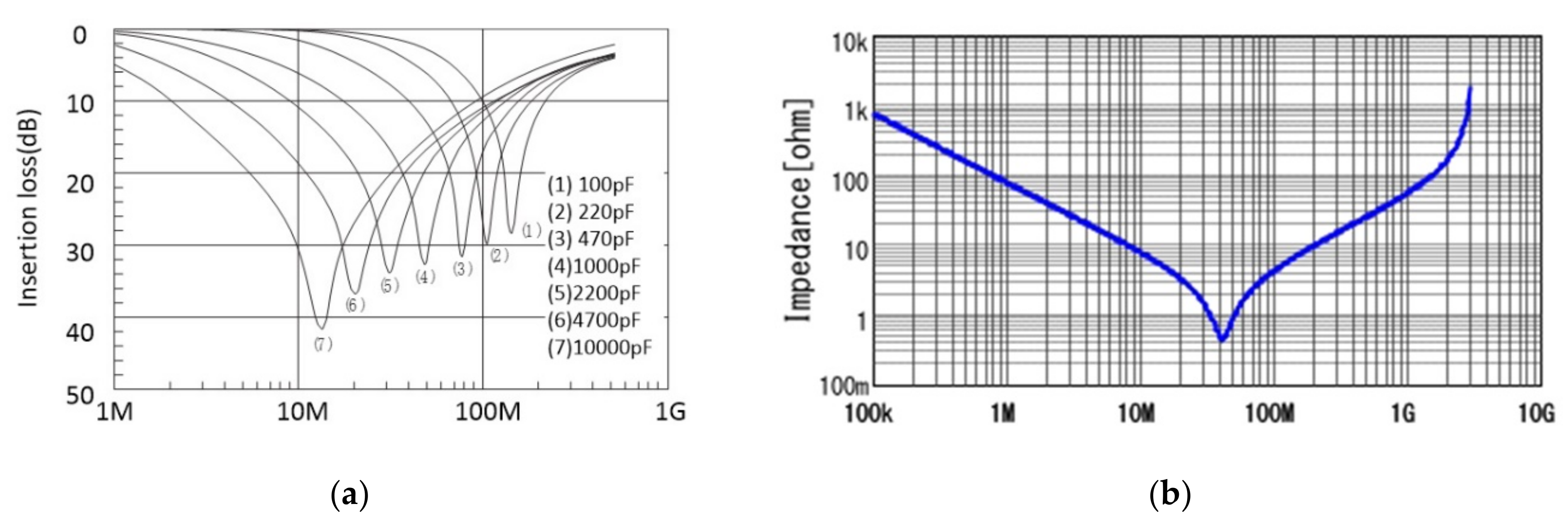
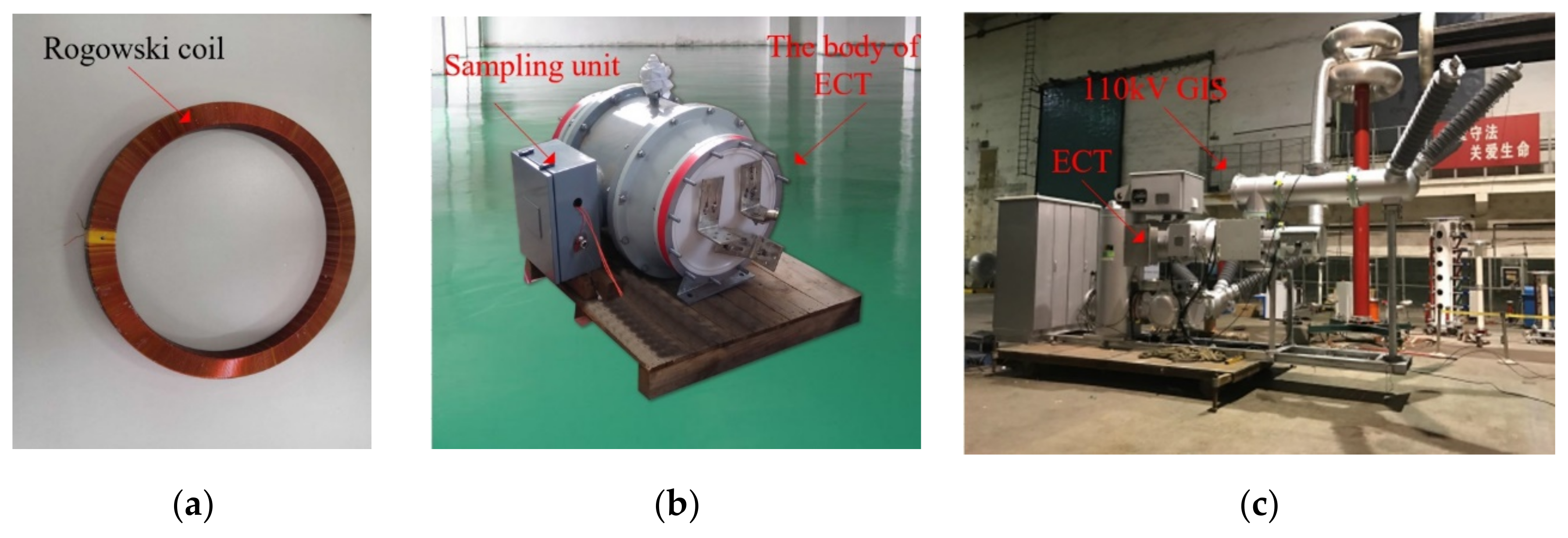
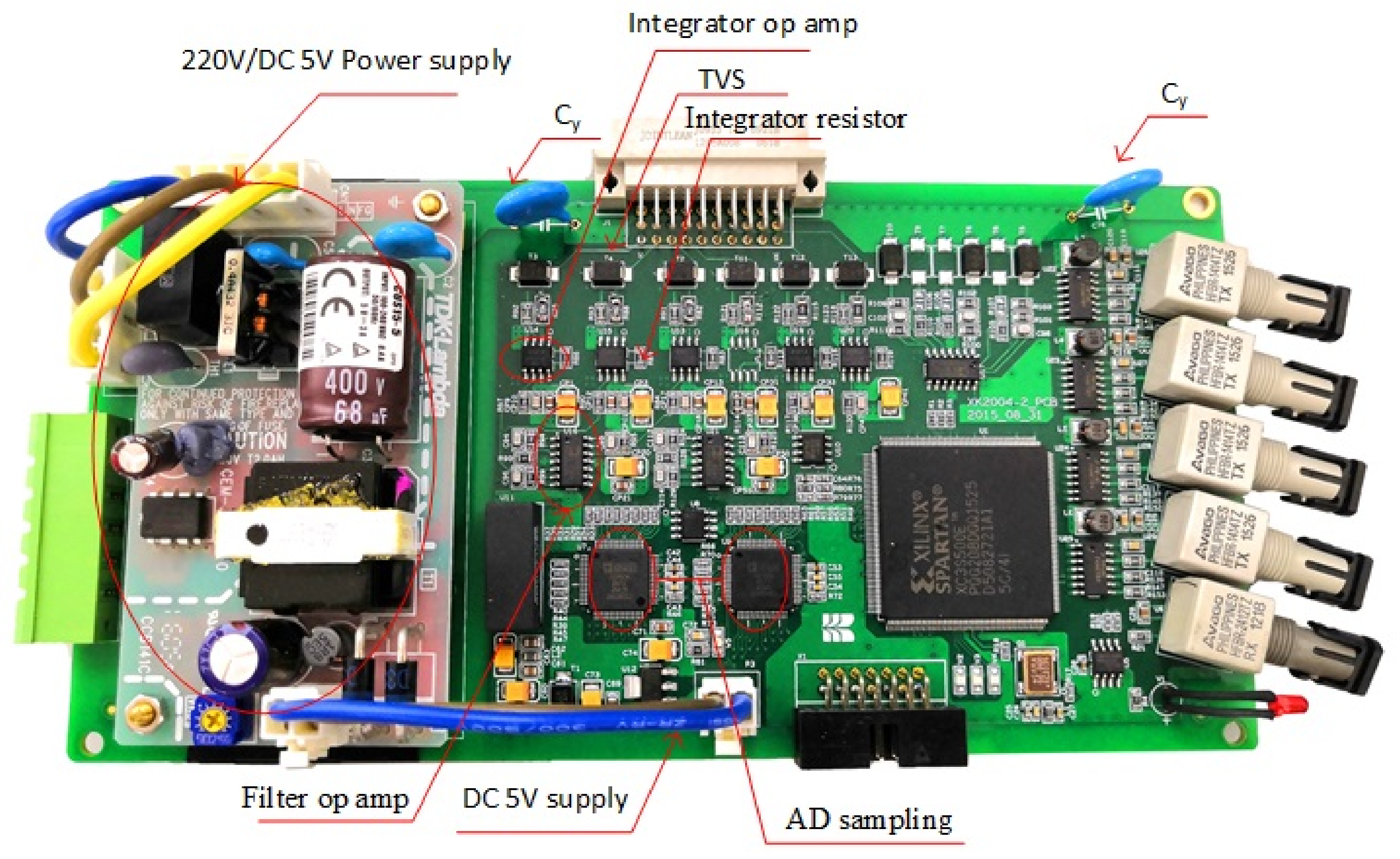
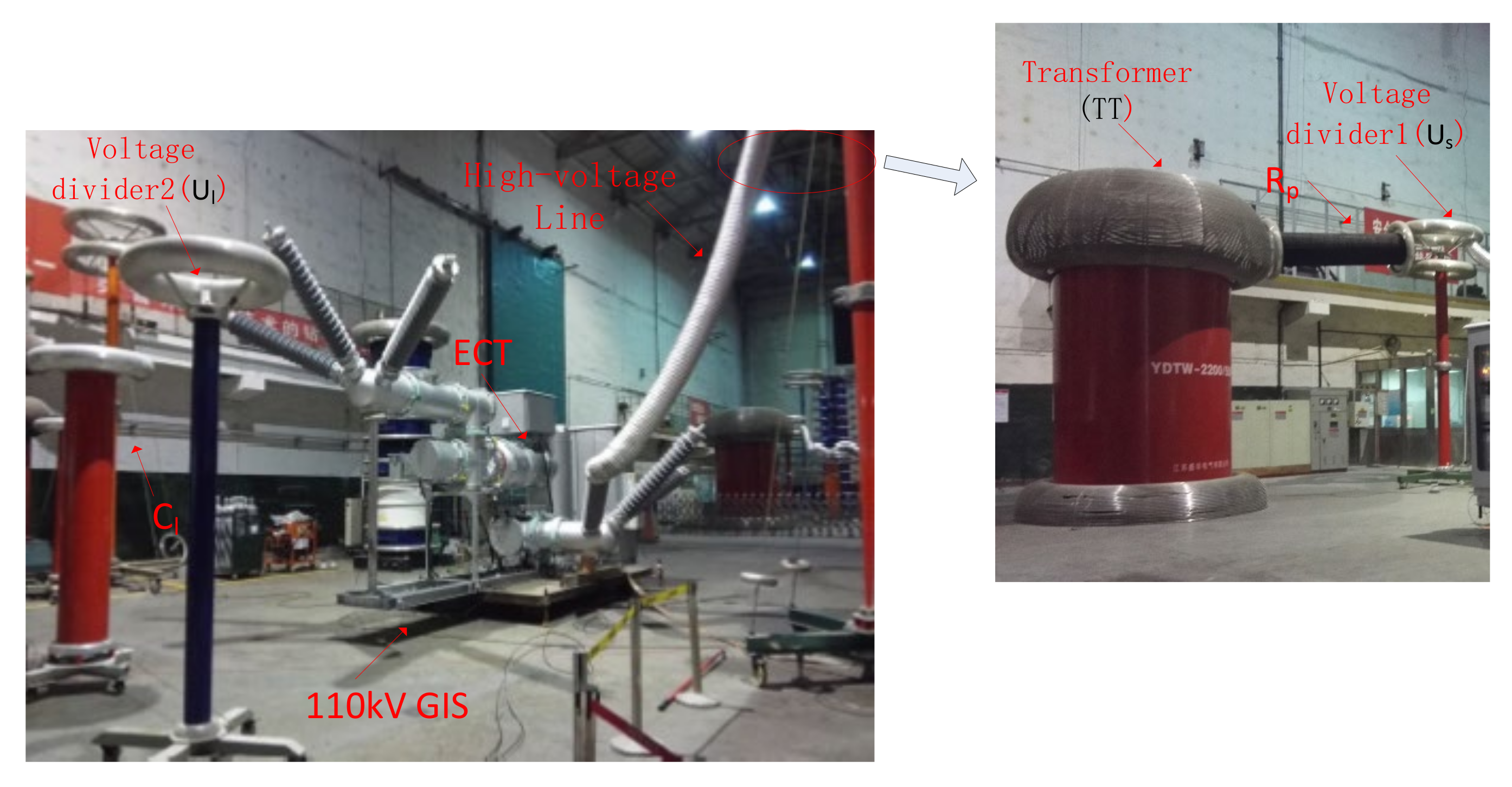


| Parameters | Notes | Value |
|---|---|---|
| TT | PF transformer (50 Hz) | 400/1600 (kV/kVA) |
| Rp | Protection resistance | 5 kΩ |
| C01 | H.V arm capacitance | 500 pF |
| C02 | L.V arm capacitance | 3 uF |
| C03 | H.V arm capacitance | 400 pF |
| C04 | L.V arm capacitance | 0.4 uF |
| Cl | Load capacitance | 22 nF |
| CT | Current transformer | |
| DS | Disconnector switch | |
| V | Voltmeter | |
| CR0 | Data Acquisition System | |
| ECT | Electronic current transformer | 5 TPE |
| Component | Notes |
|---|---|
| Transformer (Power) | L = 20 mH, C = 1000 pF |
| High voltage line | Z = 350–400 Ω |
| Gas-to-air Bushing | Transmission line of surge impedance 250 Ω and capacitance of 20 pF towards ground on either end of the contacts. |
| Spacers | Capacitance of 20 pF towards ground. |
| GIS bus bar | Z = 40–90 Ω, v = 270 m/us |
| Circuit breaker (CB) | Transmission line of surge impedance 23.4 Ω and capacitance of 20 pF towards ground on either end of the contacts. In open condition, a capacitance of 40 pF between contacts. |
| Earthing switch (ES) | Equivalent circuit of the Rogowski coil |
| ECT | Current transformer |
| CVT1 | C01 = 500 pF, C02 = 3 uF |
| CVT2 | C03 = 400 pF, C04 = 0.4 uF |
| Disconnector switch (DS) | |
| Load capacitance | 22 nF |
| Parameters | Notes |
|---|---|
| Type of isolation switch | Slow, electric |
| closing (mm) | 97.5 |
| L, Fracture distance (mm) | 55 |
| opening time (ms) | 685 |
| vopen, Opening speed (m/s) | 0.062 |
| closing time (ms) | 792 |
| vclose, closing speed (m/s) | 0.069 |
| Style | Parameters | Value |
|---|---|---|
| Structure | rb (outer radius)/m | 0.11 |
| ra (internal radius)/m | 0.095 | |
| H(height)/m | 0.015 | |
| B(width)/m | 0.015 | |
| N/turns | 543 | |
| Electromagnetism | M/uH | 0.2387 |
| L0/mH | 0.13 | |
| C0/uF | 0.0418 | |
| R0/Ω | 7.135 | |
| Rs/Ω | 15 k |
Publisher’s Note: MDPI stays neutral with regard to jurisdictional claims in published maps and institutional affiliations. |
© 2021 by the authors. Licensee MDPI, Basel, Switzerland. This article is an open access article distributed under the terms and conditions of the Creative Commons Attribution (CC BY) license (https://creativecommons.org/licenses/by/4.0/).
Share and Cite
Bai, S.; Yue, F.; Zeng, L.; Li, Y.; Wang, C.; Wang, X.; Rong, M. A Study to Resist Conduced Interference from GIS Bus-Charging Currents Switching for Electronic Current Transformer. Electronics 2021, 10, 957. https://doi.org/10.3390/electronics10080957
Bai S, Yue F, Zeng L, Li Y, Wang C, Wang X, Rong M. A Study to Resist Conduced Interference from GIS Bus-Charging Currents Switching for Electronic Current Transformer. Electronics. 2021; 10(8):957. https://doi.org/10.3390/electronics10080957
Chicago/Turabian StyleBai, Shijun, Fanding Yue, Lincui Zeng, Yi Li, Chuanchuan Wang, Xiaohua Wang, and Mingzhe Rong. 2021. "A Study to Resist Conduced Interference from GIS Bus-Charging Currents Switching for Electronic Current Transformer" Electronics 10, no. 8: 957. https://doi.org/10.3390/electronics10080957
APA StyleBai, S., Yue, F., Zeng, L., Li, Y., Wang, C., Wang, X., & Rong, M. (2021). A Study to Resist Conduced Interference from GIS Bus-Charging Currents Switching for Electronic Current Transformer. Electronics, 10(8), 957. https://doi.org/10.3390/electronics10080957







